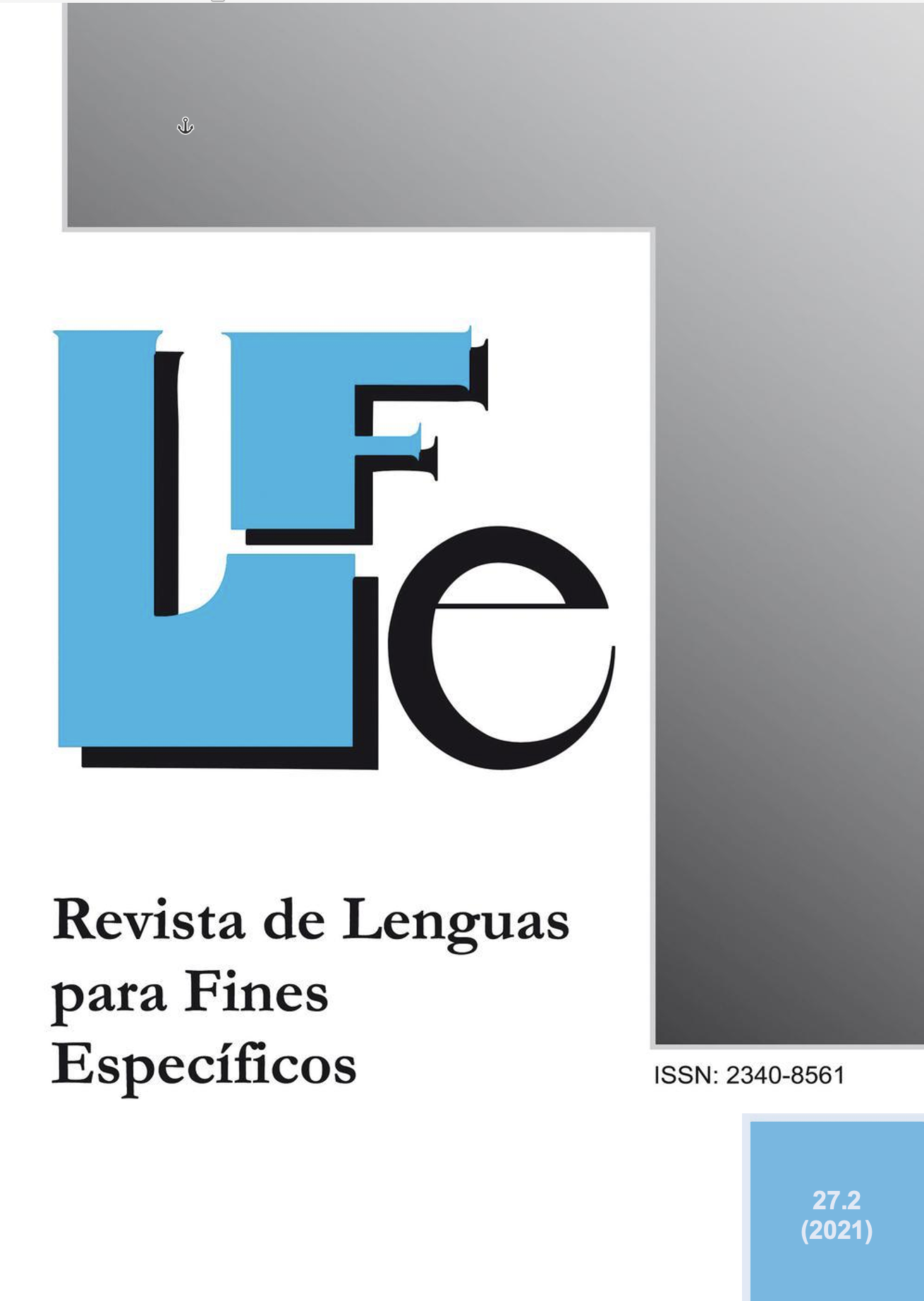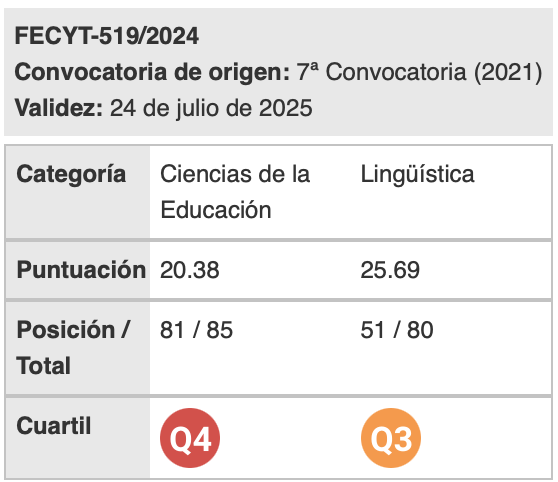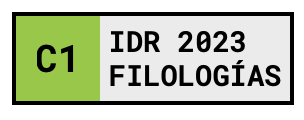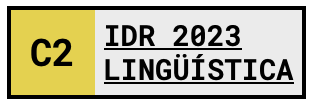catalán
Keywords:
clinical case report, medical genres, specialized discourse, discourse community, communicative purposesAbstract
In this article, we explore the formal characteristics of the genre of clinical case reports, namely length, structure, authorship, titles and features of the various sections they normally comprise. We work with a corpus in Catalan, Spanish and English of clinical case reports on mental health, particularly from the fields of neurology, psychiatry and psychology. We present numerical data and qualitative observations that reveal some of the traits and trends of this genre, in relation to the communicative purposes and the peculiarities of the communities of practice in which they are produced. We contrast the data and observations gathered from the corpus with the prescriptive texts on the genre, drawn up by the discursive communities themselves, as well as with the pertinent bibliography produced mostly in the field of discourse analysis.
Downloads
References
Burdiles, Gina (2016). Género Caso Clínico: Organización retórica de su macromovida Relato del Caso en publicaciones médicas chilenas. Revista Signos, 49(91), p. 192-216.
Cohen, Henry (2006). How to Write a Patient Case Report. American Journal of Health-System Pharmacy, 63, p. 1888-1892.
Green, Bart N. i Claire D. JOHNSON (2006). How to Write a Case Report for Publication. Journal of Chiropractic Medicine, 2(5), p. 72-82.
Har-El, Gady (1999). Does It Take a Village to Write a Case Report?. Otolaryngology–Head and Neck Surgery, 120, p. 787-788.
Jenicek, Milos (2001). Clinical Case Reporting in Evidence-Based Medicine, Londres: Arnold.
Johnson, Claire (2005). Questioning the importance of authorship. Journal of Manipulative and Physiological Therapeutics, 28, p. 149-150.
Koťátková, Adéla (2019). El relat en l’àmbit sanitari: els casos clínics sobre afeccions mentals (tesi doctoral). Castelló de la Plana: Universitat Jaume I.
Koťátková, Adéla (2020). Els casos clínics sobre afeccions mentals: entre la despersonalització i la humanització. Panace@, 51, p. 24-31.
Koťátková, Adéla (2021). El gènere discursiu dels casos clínics, Sintagma, 33, p. 27-46.
Kunt-Akbaş, Semra (2013). A Genre Analysis of Medical Case Reports. <https://www.academia.edu/2452076/A_Genre_Analysis_of_Medical_Case_Reports> [10/06/2021].
Macián, Cecili (2013). La construcción discursiva de la profesión podológica: aplicación al análisis de un corpus de revistas especializadas (tesi doctoral), Universitat Jaume I.
Morales, Óscar Alberto (2010). Los géneros escritos de la odontología hispanoamericana. Estructura retórica y estrategias de atenuación en artículos de investigación, casos clínicos y artículos de revisión (tesi doctoral), Universitat Pompeu Fabra.
Morales, Óscar Alberto, Daniel Cassany, Ernesto Ilich Marín-Altuve i Carolina González-Peña (2007). El discurso escrito de la Odontología: análisis retórico discursivo de casos clínicos hispanos (1999-2005). MedULA: Revista de la Facultad de Medicina, 16(2), p. 75-82.
Muñoz, Carlos Arturo (2011). Análisis contrastivo y traductológico de textos médicos (inglés-español). El género caso clínico (tesi doctoral), Universitat Autònoma de Barcelona.
Neely, J. Gail, Ron J. Karni, Brian Nussenbaum, Randal C. Paniello, Patrick L. Fraley, Eric W. Wang i Jason T. Rich (2008). Practical Guide to Understanding the Value of Case Reports. Otolaryngology-Head and Neck Surgery, 138, p. 261-264
Salvador, Vicent (2017). El proyecto ‘Lenguaje y cultura de la salud’. en Ana María Cestero Mancera i María Eugenia Olimpio de Oliveira Silva (eds.). Investigaciones actuales en Lingüística. Vol. IV: Sobre el discurso, Alacalá de Henares: Universidad de Alcalá.
Taavitsainen, Irma (2011). Medical Case Reports and Scientific Thought-Styles. Revista de Lenguas para Fines Específicos, 17, p. 75-98.
Uribarri, Iris (2004). La descripción científica y el caso clínico. Oftalmológica Santa Lucia, 3(3), p. 95-104.
Vandenbroucke, Jan P. (1999). Case Reports in an Evidence-based World. Journal of the Royal Society of Medicine, 92(4), p. 159-163.
Corpus citat
Alba-Martín, R. (2016). Síndrome de Mowat-Wilson: historia de vida de la fortaleza de una madre. Revista Científica de la Sociedad Española de Enfermería Neurológica, 44(C), p. 25-30. <https://doi.org/10.1016/j.sedene.2016.06.002> [8/3/2021].
Arévalo-Sáenz, A., M. Pedrosa-Sánchez i R. García de Sola (2017). Bromocriptina: ¿podría ser la cura para el mutismo acinético posquirúrgico?. Revista de Neurología, 64(2), p. 70-74. <https://doi.org/10.33588/rn.6402.2016430> [8/3/2021].
Azevedo Moreira, L.M. i L. Damasceno Espirito Santo (2013). Matrimoni i reproducció en una dona amb síndrome de Down. Revista Mèdica Internacional sobre la Síndrome de Down, 17(3), p. 39-42.
Calderón Chongo, Á. A. i R. Barreto Castro (2013). Psicosis lúpica. Presentación de un caso. Revista Electrónica PortalesMedicos.com. <https://www.revista-portalesmedicos.com/revista-medica/psicosis-lupica-caso-clinico/> [8/3/2021].
Casero-Alcázar, M., M. C. Díaz-García i F. Paredes-Fernández (2017). Caso clínico: síndrome de Von Hippel-Lindau, una visión desde enfermería. Revista Científica de la Sociedad Española de Enfermería Neurológica, 45(C), p. 24-29. <https://doi.org/10.1016/j.sedene.2016.09.001> [8/3/2021]
Conde Muñoz, B., V. Llamazares Muñoz i M. Á. Muñoz Muñoz (2017a). Caso clínico. Cuando menos te lo esperas. Revista Electrónica PortalesMedicos.com. <https://www.revista-portalesmedicos.com/revista-medica/caso-clinico-cuando-menos-te-lo-esperas/> [8/3/2021].
Conde Muñoz, B., V. Llamazares Muñoz i M. Á. Muñoz MuñoZ (2017b). Caso clínico. Doctora ¡creo que la veo doble!. Revista Electrónica PortalesMedicos.com. <https://www.revista-portalesmedicos.com/revista-medica/caso-clinico-veo-doble/> [8/3/2021].
Conde Muñoz, B., V. Llamazares Muñoz i M. Á. Muñoz Muñoz (2017c). Caso clínico. Una demencia como otra cualquiera. Revista Electrónica PortalesMedicos.com. <https://www.revista-portalesmedicos.com/revista-medica/caso-clinico-demencia/> [8/3/2021].
Eyzawiah, H., A. Suraya i A. Asma (2013). Síndrome de Down amb anomalia de l’orella interna: és adequat l’implant coclear?. Revista Mèdica Internacional sobre la Síndrome de Down, 17(2), p. 25-28.
Fernández-García, M. A., J. J. García-Peñas, H. Gómez-Martín, I. Pérez-Sebastián, E. García-Esparza i S. Sirvent-CERDÁ (2017). Alteraciones reversibles en la neuroimagen asociadas al tratamiento con vigabatrina en lactantes con espasmos epilépticos?. Revista de Neurología, 64(4), p. 169-174. <https://doi.org/10.33588/rn.6404.2016157> [8/3/2021].
Garzón Ruiz, J., E. Fajardo-Picó, J. Aguilar-García, C. Ruiz-Guerrero, R.M. Miranda Matilla i M.A. Iribarren-Marín (2011). Discussió i revisió de la bibliografia a partir del cas d’un home jove amb síndrome de Down i trombosi venosa cerebral. Revista Mèdica Internacional sobre la Síndrome de Down, 15(3), p. 37-40.
González Ablanedo, M. R., M. I. Curto Prada, M. L. Gómez Gómez i R. Molero Gómez (2013). Prosopagnosia, la discapacidad para reconocer una cara conocida. Revista Científica de la Sociedad Española de Enfermería Neurológica, 38(1), p. 53-59. <https://doi.org/10.1016/j.sedene.2013.10.002> [8/3/2021].
Hanuška, J. i J. Klener (2017). Significant Brain Oedema in Unruptured Brain Arteriovenous Malformation – A Case Report. Czech and Slovak Neurology and Neurosurgery, 80/113(3), p. 350-352. <https://doi.org/10.14735/amcsnn2017350> [8/3/2021].
Henrich Zannier, M. i À. Morral Subirà (2018). Història d’una nena que jugava a construir-se a si mateixa. Desenvolupament de la identitat corporal d’una nena amb trastorn de l’espectre de l’autisme a través d’una psicoteràpia psicomotriu. Desenvolupa: la Revista d’Atenció Precoç. <http://www.desenvolupa.net/esl/Ultimos-articulos/Historia-d-una-nena-que-jugava-a-construir-se-a-si-mateixa-Melania-Henrich-Zannier-Angels-Morral-Subira-02-2018-Nuevo> [8/3/2021].
Herrería Herrera, R., E. Ruiz Casuso i V. Palacios Pérez (2017). Alicia en el país de las maravillas. Revista Electrónica PortalesMedicos.com. <https://www.revista-portalesmedicos.com/revista-medica/alicia-pais-las-maravillas/> [8/3/2021].
Kubota, S., M. Yamada, H. Satoh, A. Satoh i M. Tsujihata (2017). Pure Amorphagnosia without Tactile Object Agnosia. Case Reports in Neurology, 9, p. 62-68. <https://doi.org/10.1159/000466684> [8/3/2021].
Novroski, A.-R. i K. J. Baldwin (2017). Chronic Autoimmune Meningoencephalitis and Periodic Fever Syndrome Treated with Anakinra. Case Reports in Neurology, 9, p. 91-97. <https://doi.org/10.1159/000472147> [8/3/2021].
Rodrigo Alfageme, M. i R. Hernández Guillén (2013). Ansiedad. Adolescere. Revista de Formación Continuada de la Sociedad Española de Medicina de la Adolescencia, XXII(1), p. 36-41. <https://www.adolescenciasema.org/caso-clinico-ansiedad-m-rodrigo-alfageme-et-al-adolescere-2013-i-1-36-41/> [8/3/2021].
Rodríguez Vicente, Y. i C. Garrido Segovia (2016). Encefalitis anti-NMDA y enfermería al alta. Revista Científica de la Sociedad Española de Enfermería Neurológica, 43(C), p. 23-29. <https://doi.org/10.1016/j.sedene.2015.12.003> [8/3/2021].
Ruiz Julián, M. (2015). Sense títol (El racó del resident). Neurologia Catalana, 26, p. 34.
Serra Martínez, M. i C. Avellaneda Gómez (2017). Home de 62 anys amb parèsia d’extremitat superior dreta. Neurologia Catalana, 32, p. 46-47.
Servei de Neurologia. Hospital Parc Taulí, Sabadell (2006). Pacient amb oligoartritis, polineuropatia i clínica abdominal. Neurologia Catalana, 1, p. 11.
Solis, W. G., S. E. Waller, A. K. Harris, E. Sugo, M. A. Hansen i J. Lechner-Scott (2017). Favourable Outcome in a 33-Year-Old Female with Acute Haemorrhagic Leukoencephalitis. Case Reports in Neurology, 9, p. 106-113. <https://doi.org/10.1159/000472706> [8/3/2021].
Striebel, J. M., E. E. Nelson i R. K. Kalapatapu (2017). “Being with a Buddha”: A Case Report of Methoxetamine Use in a United States Veteran with PTSD. Case Reports in Psychiatry. <https://doi.org/10.1155/2017/2319094> [8/3/2021].
Downloads
Published
How to Cite
Issue
Section
License
Authors who publish with this journal agree to the following terms:
- Authors retain copyright and grant the journal right of first publication with the work simultaneously licensed under a Creative Commons Attribution License that allows others to share the work with an acknowledgement of the work's authorship and initial publication in this journal.
- Authors are able to enter into separate, additional contractual arrangements for the non-exclusive distribution of the journal's published version of the work (e.g., post it to an institutional repository or publish it in a book), with an acknowledgement of its initial publication in this journal.
- Authors are permitted and encouraged to post their work online (e.g., in institutional repositories or on their website) prior to and during the submission process, as it can lead to productive exchanges, as well as earlier and greater citation of published work (See The Effect of Open Access).

Revista de Lenguas para fines específicos is licensed under a Creative Commons Reconocimiento-NoComercial-SinObraDerivada 4.0 Internacional License.

























